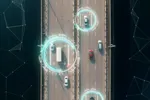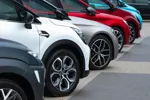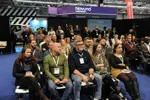ESP
ELECTRONIC Stability Programme is becoming a regular feature on new cars. Developed by Bosch and launched with Mercedes-Benz in 1995, the system uses sensors to detect a possible spin in a car and correct it.
Sideways motion of the car is measured and compared to expected levels. Whenever a discrepancy is detected, individual brakes are applied to the relevant wheels to bring them back on track. Bosch aims to have ESP fitted on a third of new cars by the end of 2005.
Usefulness for fleets: The technology was hailed as a lifesaver by
Matthew Avery, crash laboratory manager at Thatcham, when he spoke at the Fleet News Double Jeopardy conference in May.
Cost: From about £200 on selected models
Blind-spot indicators
VOLVO was the first carmaker to fit a wide-angle blind spot mirror to improve drivers’ visibility, and has taken that one step further with its BLIS system. It uses a camera in each side mirror to monitor the blind spots. When another vehicle enters the monitored zone, a lamp comes on in the relevant mirror. The system started going into production XC90s this month. Audi has a similar system that uses sensors to detect other cars to the side of the vehicle. Again, a warning light shines in the corresponding mirror to indicate the car’s presence.
Usefulness for fleets: Flashy, but what’s wrong with a blindspot mirror?
Cost: £650
Parking
NISSAN is going further than standard parking sensors and cameras, and is working on a system that uses cameras all around the car.
The images are processed to create a bird’s eye view image of the car and its surroundings, displayed on a monitor in the vehicle. As well as eliminating blind spots, Nissan predicts it will be especially useful when parking, but says it is unlikely to go on sale until 2008 at the earliest. Volkswagen is also working on a similar product.
Usefulness for fleets: Hard to say as the system is still in development, but could prove popular after the success of parking sensors.
Cost: Not available
Autopilot
EXPERTS at GM are claiming the 2008 Vauxhall Vectra (Fleet NewsNet, August 25) will have an autopilot function, called Traffic Assist, capable of driving itself at speeds of up to 60mph in heavy traffic without any input from the driver.
Assorted gizmos allow the car to carry out all the steering, acceleration and braking needed to navigate main road traffic jams while the driver kicks back and relaxes. An array of video cameras, lasers and computers can ‘see’ road signs, bends and lane marking to keep the vehicle in position. The same technology is expected to also crop up on the replacement for the Saab 9-3.
Usefulness for fleets: Would you rather have a computer or some of your drivers controlling the cars? It’s a tough call…
Cost: From £1,500
Night vision
AUDI’S forthcoming Road Vision uses laser and infrared sensors to recognise the type of road the car is on and the surface conditions. It can inform the driver via the instrument panel of conditions such as gravel or black ice, and transmits the information to the ESP system and adaptive cruise control to compensate.
Manufacturers including Mercedes-Benz and BMW are working on infrared night vision technology. This uses infrared light projected in front of the car that is picked up by a camera and displayed on a monitor to the driver. This could prove useful as a back-up view of the road ahead – for example, when oncoming headlights dazzle. Expect to see such technology on the new Mercedes-Benz S-class and the next BMW 7-series.
Usefulness for fleets: The promise of better vision in the dark is
alluring, but the concept of driving by dashboard could be unnerving.
Cost: Not available
Lane departure
A VIDEO camera monitors the white lane marker lines on the road and, if the car veers over them without indicating, the driver is warned in a number of ways depending on the marque.
Citroen’s system vibrates the seat on the corresponding side, Volkswagen’s will sound an alarm and Audi’s vibrates the steering wheel. Honda’s new Lane Keeping Assist System, planned for the 2006 Accord, takes things a step further. It uses the information from the camera to tell the power steering to keep the car in lane. A beeping noise alerts the driver, who can override the system by turning the wheel.
Usefulness for fleets: Limited, unless your drivers have a tendency to fall asleep.
Cost: £300
Adaptive cruise control
ADAPTIVE cruise control technology that was once the preserve of prestige manufacturers is also now filtering down to volume brands.
The various systems use radar sensors to detect objects up to 120 meters in front of the vehicle and automatically adjust the vehicle’s speed to maintain a safe driving distance. The technology can have different names depending on marque. Many, including Jaguar, Honda, Volvo, Audi and Ford all call it simply adaptive cruise control, whereas Mercedes-Benz refers to it as Distronic.
Usefulness for fleets: Very useful, especially on busy motorways. Acts as an extra pair of eyes should the driver become distracted.
Cost: From £1,000 unless standard
Fitness-to-drive detector
Despite hard-hitting campaigns drink-driving remains a problem, so Saab has developed an ignition key that requires drivers to breathe into it to prove they are below the drink-drive limit.
Usefulness for fleets: Could stop drivers from getting behind the wheel after a skinful, but should your drivers be drinking and driving in the first place?
Cost: £150 option from 2006
But even sober drivers can doze off after a long day, prompting Volkswagen and Saab to develop attention control systems. Miniature cameras monitor the driver’s blinking movements, which detect patterns that indicate tiredness, and sound an alarm.
Usefulness for fleets: Only a temporary solution to the more worrying long-term prospect of drivers falling asleep.
Cost: Not available
Sign recognition
VOLKSWAGEN is preparing to release a traffic sign recognition system that sees signs such as speed limits and gives a digital or audible alert to the driver.
Two such systems are currently being tested. The first uses information gleaned from the navigation system, constantly fed with the latest traffic information via digital radio broadcasts. The second system receives its data via radio transmitters installed on the traffic signs. It will display information about the start and end of speed limits on a dashboard display. Both systems are still in development and there are as yet no plans to include them in production cars.
Usefulness for fleets: A machine that sees road signs? Shouldn’t the driver be doing that?
Cost: Not available
















Login to comment
Comments
No comments have been made yet.